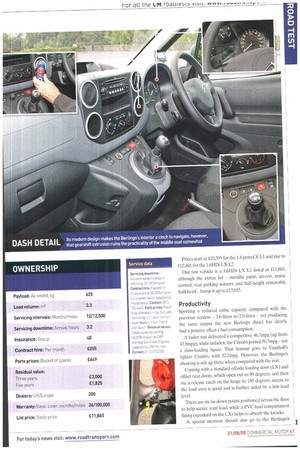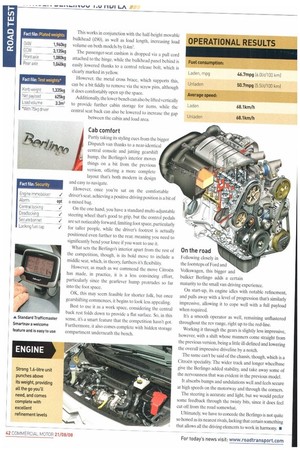Considering Citroen's position as one half of a French double
Page 40

Page 41

Page 42

If you've noticed an error in this article please click here to report it so we can fix it.
act alongside Peugeot, and its continued relationship with Fiat, with which it develops most of its CVs, the commercial success of the brand when compared with the aforementioned two is certainly something to be admired.
Continually knocking on Volkswagen's number three position in the sales charts, the company often punches above its weight, with attractively priced products that are generally seen as consistent, if not class-leading.
The previous Berlingo was a competent all-rounder. with the original version helping to define the class.
But times move on, Ford has now set the benchmark with its heavier, more focused Transit Connect, which comes with some 'big van' refinements. But now it's the turn of Citroen again...
Now available in two wheelbases (L1 and L2). the new version of the Berlingo is bigger and heavier than the outgoing model.
The Li is 240mm longer, while the L2 adds another 491inm. This in turn allows load volume to grow, now 3.3m' and 3.7m3 respectively, up from the previous 3.0m3.
GVWs also range from 1,960kg to 2,185kg. allowing payload to take a noticeable hike — there are three ratings to choose from depending on vehicle size — 625kg, 750kg and 850kg.
Power comes from a 1.6-litre turbo-diesel engine with common-rail technology, producing either 75hp or 90hp, and a 1.6-litre 16-valve petrol unit with 90hp.
All engines come with a five-speed manual gearbox: while the company's clutchless manual, called SensoDrive, is an option.
There are two trim levels to choose from: L and LX. The former includes central locking and electric front windows, while the latter adds remote central locking. electric heated door mirrors and a CD/radio combo.
All versions also come with Trafficnnaster's Smartnav satellite navigation system, complete with Trackstar stolen vehicle system — a rather useful addition considering the Berlingo's urban aspirations. Prices start at £10,395 for the 1.6 petrol X Li and rise to £12,465 for the 1.6HDi LX L2, Our test vehicle is a 1.6HDi LX Li listed at £11,865, although the extras list — metallic paint, air-con, cruise control, rear parking sensors, and half-height removable bulkhead — bump it up to £13,655,
Productivity
Sporting a reduced cubic capacity compared with the previous version — 1.6-litres to 2.0-litres — yet producing the same output the new Berlingo diesel has clearly had a positive effect s fuel consumption.
A laden run delivered a competitive 46.7mpg (up from 42.8mpg), while unladen, the Citroen posted 50.7mpg — not a class-leading figure. That honour goes to Vauxhall's lighter Combo, with 52.2mpg. However, the Berlingo's showing is still up there when compared with the rest.
Coming with a standard offside loading door (LX) and offset rear doors. which open out to 90 degrees, and then via a release catch on the hinge to 180 degrees, access to the load area is good and is further aided by a low-load level.
There are six tie-down points positioned across the floor to help secure your load, while a PVC load compartment lining (standard on the LX) helps to absorb the knocks.
A special mention should also go to the Berlingo's
This works in conjunction with the half-height movable bulkhead (i90), as well as load length, increasing load volume on both models by 0.4m3.
The passenger-seat cushion is dropped via a pull cord attached to the hinge, while the bulkhead panel behind is easily lowered thanks to a central release bolt, which is clearly marked in yellow.
However, the metal cross brace, which supports this, can be a bit fiddly to remove via the screw pins, although it does comfortably open up the space.
Additionally, the lower bench can also be lifted vertically to provide further cabin storage for items, while the central seat back can also be lowered to increase the gap between the cabin and load area.
Cab comfort Partly taking its styling cues from the bigger Dispatch van thanks to a near-identical central console and jutting gearshift hump, the Berlingo's interior moves things on a bit from the previous version, offering a more complete layout that's both modem in design and easy to navigate.
However, once you're sat on the comfortable driver's seat, achieving a positive driving position is a bit of a mixed bag.
On the one hand, you have a standard multi-adjustable steering wheel that's good to grip, but the control pedals are set noticeably forward, limiting foot space, particularly for taller people, while the driver's footrest is actually positioned even further to the rear, meaning you need to significantly bend your knee if you want to use it.
What sets the Berlingo's interior apart from the rest of the competition, though, is its bold move to include a middle seat, which, in theory, furthers it's flexibility.
However, as much as we commend the move Citroen has made, in practice, it is a less convincing effort, particularly since the gearlever hump protrudes so far into the foot space.
OK, this may seem feasible for shorter folk, but once gearshifting commences, it begins to look less appealing.
Best to use it as a work space, considering the central back rest folds down to provide a flat surface. So, in this sense, it's a smart feature that the competition hasn't got Furthermore, it also comes complete with hidden storage compartment underneath the bench.
On the road Following closely in the footsteps of Ford and Volkswagen, this bigger and bulkier Berlingo adds a certain
maturity to the small van driving experience.
On start-up, its engine idles with notable refinement, and pulls away with a level of progression that's similarly impressive, allowing it to cope well with a full payload when required.
It's a smooth operator as well, remaining unflustered throughout the rev range, right up to the red-line.
Working it through the gears is slightly less impressive, however, with a shift whose manners come straight from the previous version, being a little ill-defined and lowering the overall impressive driveline by a notch.
The same can't be said of the chassis, though, which is a Citroen speciality. The wider track and longer wheelbase give the Berlingo added stability, and take away some of the nervousness that was evident in the previous model.
It absorbs bumps and undulations well and feels secure at high speeds on the motorway and through the comers.
The steering is accurate and light, but we would prefer some feedback through the twisty bits, since it does feel cut off from the road somewhat.
Ultimately, we have to concede the Berlingo is not quite so honed as its nearest rivals, lacking that certain something that allows all the driving elements to work in harmony. •












































































































































































